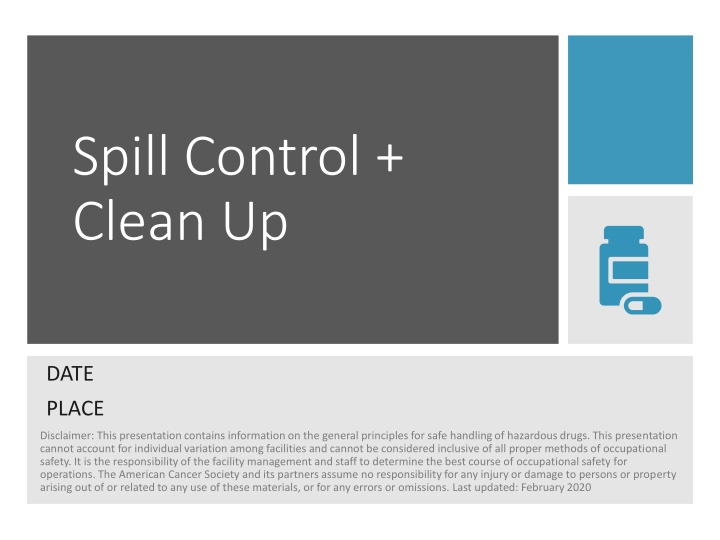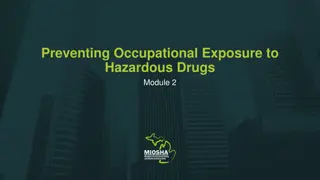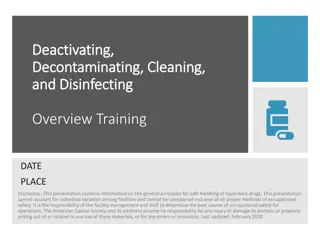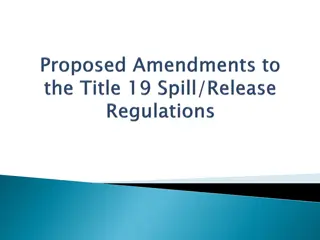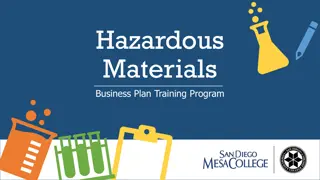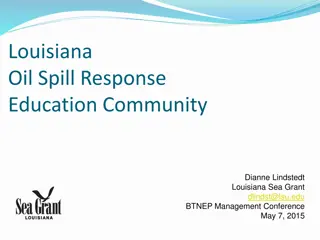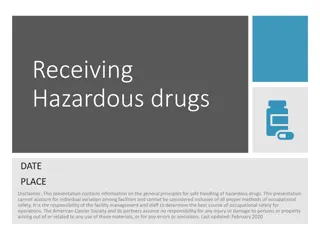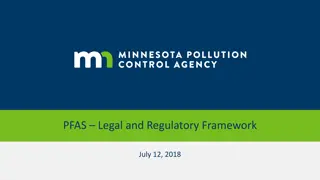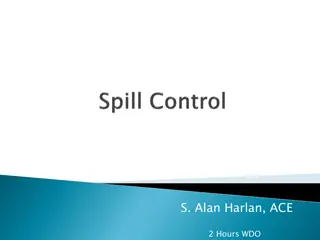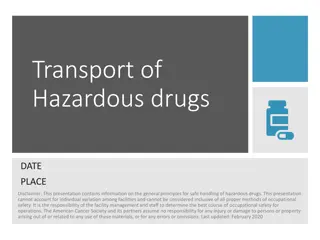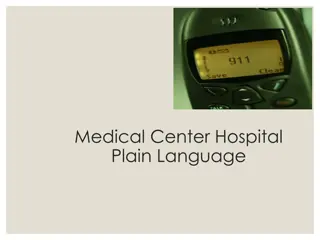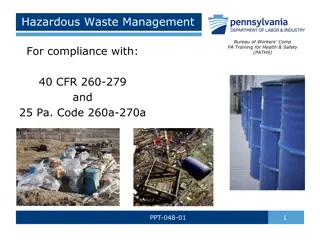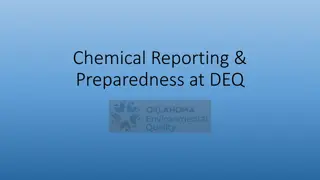Hazardous Drugs Spill Control and Clean-Up Guidelines
Learn about safe handling of hazardous drugs through spill control and clean-up procedures. This presentation covers identifying spills, using spill kits, cleaning spills, reporting, and documentation. Proper training and procedures are essential to protect personnel from exposure risks. Always follow facility-specific protocols for managing hazardous drug spills to ensure occupational safety.
Download Presentation

Please find below an Image/Link to download the presentation.
The content on the website is provided AS IS for your information and personal use only. It may not be sold, licensed, or shared on other websites without obtaining consent from the author.If you encounter any issues during the download, it is possible that the publisher has removed the file from their server.
You are allowed to download the files provided on this website for personal or commercial use, subject to the condition that they are used lawfully. All files are the property of their respective owners.
The content on the website is provided AS IS for your information and personal use only. It may not be sold, licensed, or shared on other websites without obtaining consent from the author.
E N D
Presentation Transcript
Spill Control + Clean Up DATE PLACE Disclaimer: This presentation contains information on the general principles for safe handling of hazardous drugs. This presentation cannot account for individual variation among facilities and cannot be considered inclusive of all proper methods of occupational safety. It is the responsibility of the facility management and staff to determine the best course of occupational safety for operations. The American Cancer Society and its partners assume no responsibility for any injury or damage to persons or property arising out of or related to any use of these materials, or for any errors or omissions. Last updated: February 2020
Personnel who come in contact with hazardous drugs (HDs) Who should take this training Personnel may include facility administration, pharmacists, nurses and cleaners 2
Training Modules + Learning Objectives Overview Describe what constitutes a spill List the contents of a spill kit and locations they should be placed Spill Kits How To Clean a HD Spill Demonstrate how to contain a spill Demonstrate how to clean a spill Reporting + Documentation Prepare reporting and documentation after a spill is cleaned 3
Any leak of an HD that is more Any leak of an HD that is more than a few drops is considered than a few drops is considered to be a spill to be a spill What is considered a spill? 4 Reference 7
Common way for workers to be exposed to HDs More about spills Range from just a few drops to a large-volume spill 5 Reference 7
The steps taken to clean-up a spill vary depending on the drug: Form Volume spilled Surface on which it spilled 6 Reference 7
Each facility should have Standard Operating Procedures (SOPs) for spill management and all workers possibly involved in spill management should be fully trained. 7 Reference 1,2
9 An HD spill kit should have supplies sufficient to clean up at least 1,000mL of volume and must include all of the PPE needed to protect a worker from exposure to HD.
Instructions for cleaning up a spill Two pairs of disposable chemical-protective gloves Low permeability, disposable protective garment (gown or coverall, shoe covers) Face shield/ splash goggles Contents of a Spill Kit Respirator (N95 or better) Absorbent, plastic-backed sheets or spill pads Disposable towels At least two sealable, thick plastic waste disposal bags A disposable scoop for collecting glass fragments A puncture-resistant container Sign saying Caution Hazardous Drug Spill Incident reporting form A full-face piece chemical cartridge-type respirator may be needed for large-volume spills 10 Reference 2
At least one kit should always be available in each area where HDs are handled. RECEIVING + STORAGE AREA DRUG PATIENT TREATMENT AREA (S) TRANSPORTATION CARTS COMPOUNDING AREA (S) Reference 1,2 11
How to Clean an HD Spill (Step by Step)
When a spill occurs: Limit exposure Remove the HD Don PPE Clean 13 Reference 7
1 4 The following are detailed steps employees should take when a spill occurs . This Photo by Unknown Author is licensed under CC BY-SA-NC
1. Assess + Isolate Assess the size and scope Obtain Spill Kit Isolate Individuals Assess the size and scope of the spill. Call for trained help, if necessary Obtain spill kit and respirator, if needed. Assess the exposure of any individuals involved and isolate them from the spill. * Spills that cannot be contained by two spill kits may require outside assistance. Reference 2,3,4
2. Prepare Area + Don PPE Place Warning Sign Mark the Area Don PPE Mark the area of the spill with a sign (contained within the spill kit) to deter people from stepping into the contaminated area Alert other staff in the area to the potential hazard and limit access by placing the warning sign in a prominent position Don PPE including double gloves, gown, eye protection, and respirator. * Wear a NIOSH-or other international standard-approved respirator, such as an N95 respirator. Note that surgical masks are not sufficiently protective. Reference 2,3,4
Donning (Putting on) PPE This Photo by Unknown Author is licensed under CC BY-ND 17
3. Contain + Clean Spill Remove Broken Glass Contain Spill Absorb Liquids Contain spill using spill kit. Always work from the outside of the spill area towards the center. Carefully remove any broken glass fragments using a disposable scoop and place them in a puncture resistant container Absorb liquids with spill pads or toweling. * If practical, a second trained worker, wearing PPE, can assist with the clean-up by holding the spill waste disposal bag. Reference 2,3,4
4. Clean Spill Place Waste in Bags Absorb Powder Rinse Area Absorb powder with damp disposable pads or soft toweling. Completely remove and place all contaminated material in the HD waste disposal bags. Rinse the area with water and then clean with detergent, sodium hypochlorite solution, and neutralizer Reference 2,3,4
5. Clean Area + Remove PPE Rinse Again + Bag Seal Bags Remove PPE Rinse the area several times and place all materials used for containment and clean up in disposal bags. Seal bags and place them in the appropriate final container for disposal as hazardous waste. Carefully remove all PPE using the inner gloves. Reference 2,3,4
Doffing (Removing) PPE This Photo by Unknown Author is licensed under CC BY-ND 21
6. Dispose of PPE + Wash Hands Remove Inner Gloves Bag + Seal Wash Hands Place all disposable PPE into disposal bags. Seal bags and place them into the appropriate final container. Remove inner gloves, contain in a small, sealable bag, and then place into the appropriate final container for disposal as hazardous waste Wash hands thoroughly with soap and water Reference 2,3,4
Post Spill Clean-Up Once a spill has been initially cleaned, have the area re- cleaned by housekeeping, janitorial staff, or environmental services per facility policy. Reference 4 23
Reporting + Documentation
Access the safety Access the safety data sheet (SDS) data sheet (SDS) for the spilled for the spilled agent to agent to determine if any determine if any inactivators are inactivators are recommended recommended This Photo by Unknown Author is licensed under CC BY 25 Reference 5,6
Name of the drug Approximate volume of spill Document and report the following per institutional policy: How the spill occurred Spill management procedures followed The names of personnel, patients, and others exposed to the spill A list of personnel notified of the spill 26 Reference 2,4
1. US Pharmacopeia. USP General Chapter <800> Hazardous Drugs-Handling in Healthcare Settings [Internet]. 2017 [cited 2018 May 7]. 2. United States Occupational Safety and Health Administration. Controlling Occupational Exposure to Hazardous Drugs [Internet]. [cited 2018 May 5]. 3. Polovich M, Olsen M, editors. Safe handling of hazardous drugs. Oncology Nursing Society; 2018 CDC - NIOSH Publications and Products NIOSH Respirator Selection Logic 2004 (2005-100) [Internet]. [cited 2018 May 17]. References 4. American Society of Health-System Pharmacists. ASHP guidelines on handling hazardous drugs. American Journal of Health-System Pharmacy. 2006;63:1172 93 5. Polovich M, Olsen M, LeFebvre K. Chemotherapy and biotherapy guidelines and recommendations for practice. 4th ed. Oncology Nursing Society; 2014 6. Gonzalez R, Massoomi FF. Manufacturers recommendations for handling spilled hazardous drugs. Am J Health-Syst Pharm AJHP Off J Am Soc Health-Syst Pharm. 2010 Dec 1;67(23):1985 6. 7. Pan American Health Organization. Safe handling of hazardous chemotherapy drugs in limited-resource settings [Internet]. 2013 27
